 One of the previous articles dealt, among other things, with the number of complaints about raspberry plants. What if the end consumer, i.e. the home gardener, comes to your company to complain about raspberry plants that did not grow well? We have compiled the most important questions and answers on the subject of raspberry plants for you. These are not so much cultivation tips for the production and cultivation of raspberry plants, but rather tips and tricks for the end consumer, which you are welcome to give the home gardener along with your advice. But of course, some of the points can be adapted to the production of raspberry plants.
One of the previous articles dealt, among other things, with the number of complaints about raspberry plants. What if the end consumer, i.e. the home gardener, comes to your company to complain about raspberry plants that did not grow well? We have compiled the most important questions and answers on the subject of raspberry plants for you. These are not so much cultivation tips for the production and cultivation of raspberry plants, but rather tips and tricks for the end consumer, which you are welcome to give the home gardener along with your advice. But of course, some of the points can be adapted to the production of raspberry plants.
When should raspberries be planted?
Raspberries in pots can basically be planted all year round; the only requirement is frost-free soil. When planting in autumn or in the spring, it is essential to tear open the matted root ball well. The shoots should also be cut back to about 20 cm. However, our recommendation for the ideal planting date is the middle of the summer between July and September. During this time, the soil is warm and dry in most cases and the raspberry roots can spread optimally, as the most feared pest, the Phytophthora fungus, is hardly active during this time. This fungus feels especially comfortable in soil that is cold and wet.

Picture: well-rooted raspberry plants from summer production, ideal for planting
How should raspberries be planted? What is our most important tip?
Tear open the root ball before planting! This is probably the main reason for poor growth results. If older and thus matted root balls are not torn open well and strongly at the time of planting, hardly any new roots will be formed. This can ultimately lead to the raspberry plants rotting in the planting hole in wet weather or drying out in the planting hole in dry weather.
At what distance should raspberries be planted?
The standard planting distance in the row is 30 cm. With this planting distance, the rows fill up very quickly and already in the second year you get a full row. If you choose a larger planting distance of 50 cm, it will take about 1-2 more years. The planting distance between the rows should not be less than 150 cm, i.e. at least as far apart as the rows are high.
Can raspberry plants be planted in a pot or container?
Growing raspberry plants in a pot or container on a balcony/terrace is quite simple and straightforward. For longer-term/several-year cultivation, the pot should have a volume of about 15-20 L. Using potting soil as a substrate has proved to be a good choice. In fact, our Lowberry® raspberries have been specially grown and selected for use as a potted plant. Our semi-tall variety group of Schlaraffia® raspberries is also well suited for growing in pots.
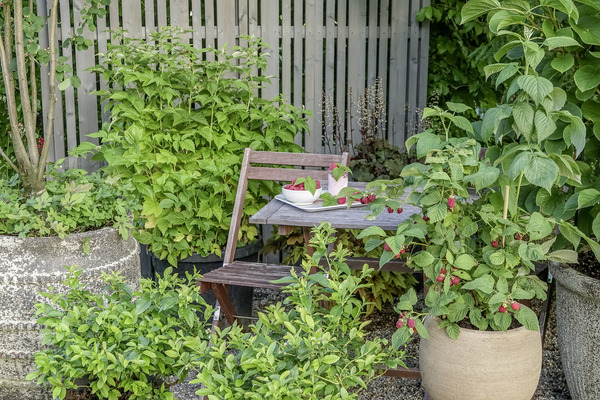
Picture: Lowberry® raspberries can also be cultivated well in a container.
Is it possible to plant raspberries in the same place where raspberries were already grown?
Probably not. As a rule, the question of reproduction arises when the previous crop has died. In this case, replanting does not make sense, as there is a risk that the new raspberries will have the same problems much more quickly. In addition, raspberries that belong to the Rosaceae family also suffer from slight reproduction depression, i.e. the second generation at the site grows systematically weaker. We recommend planting blackberries or climbing fruit plants (kiwis, grapes) on an existing raspberry framework.
Pruning raspberries – what to watch out for!
Ultimately, only two things need to be considered when pruning raspberry plants.
- In the case of summer raspberries, the fruits form on the canes grown last year and only those shoots that have borne fruit are cut back completely after harvesting.
- In the case of autumn raspberries – the fruit forms on the tips of the canes grown this year – all of the shoots are cut back at ground level after the winter but before new shoots appear. If you leave a few canes standing, you can enable overwintering beneficial insects to move to the newly growing shoots during the winter.
When should raspberries be pruned?
- Summer raspberries – the harvested shoots are cut immediately after harvesting (late summer/early autumn)
- Autumn raspberries – the shoots are cut after the winter but before the new shoots appear (end of February)
What type of soil is most ideal for raspberries?
Raspberries love a rather light soil with humus. They dislike stagnant moisture and even in heavy soils, the roots are reluctant to find their way around. If the soil is very heavy, a mound should be piled up from a mixture of compost, topsoil and, if necessary, sand. A dam about 40 cm high should be built on top of this mound and then the raspberries can be planted. This way the roots do not stand directly in the heavy and mostly too wet soil.
What is the best location for raspberry plants?
In full sun, in an open and preferably somewhat windy location. The leaves and branches dry out more quickly and fungal diseases cannot take hold.
Should raspberries be mulched?
No! Raspberry rows must never be covered with mulch material under any circumstances. Such a mulch layer acts as insulation, with the result that the soil underneath remains considerably wetter and cooler than without mulch. These are in turn the ideal conditions for the dreaded Phytophthora fungus. In the spring it is possible to spread compost, but this compost should be chopped into the soil as directly as possible. If you catch one or the other root during this work, this is even more positive than negative. Injuries to the root will encourage the plant to form new canes.
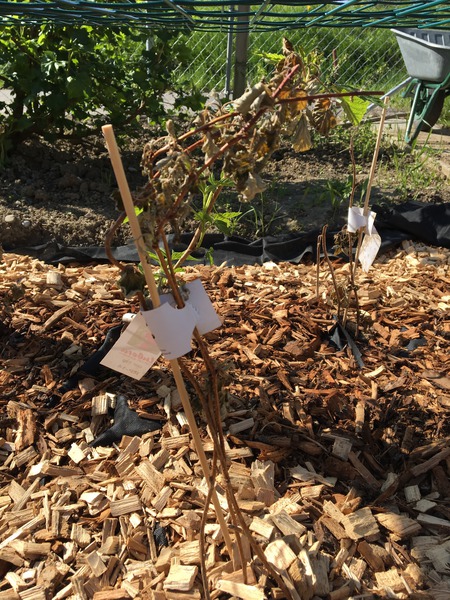
BIld: raspberries mulched to death, wood chips on Mulchvlies
Do raspberry plants need a lot of water?
When the fruit ripens, raspberries need quite a lot of water, but their root system should be able to get this water during this time. Raspberries should only be watered in absolutely exceptional situations. As a matter of principle, raspberries should be kept as dry as possible during growth; then they are healthiest.
What is the difference between summer raspberries and autumn raspberries?
Summer raspberries bear fruit on last year's canes, on the side shoots of 2-year-old wood; autumn raspberries develop flowers and fruit on this year's wood.
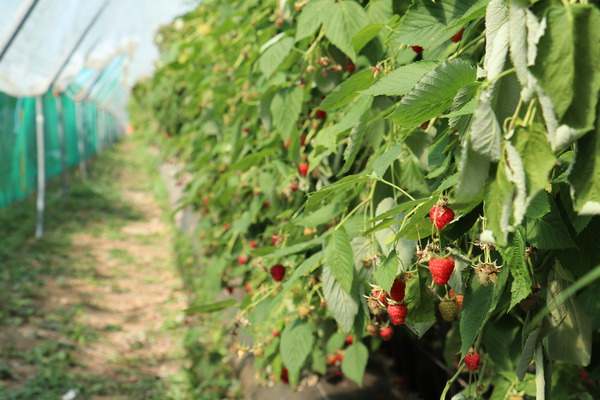
Picture: floricane raspberries flower and bear fruit on the shoots of last year's canes

Picture: primocane raspberries flower and bear fruit at the ends of this year's shoots
Overwintering raspberry plants – how does that work?
Overwintering raspberry plants is not a big problem. But especially with summer raspberries, it is of course essential that this year's shoots get through the winter well and then bear the longed-for fruit. For this to happen, the canes must be healthy and not show too many growth cracks. Usually, there are far too many new canes growing, so that in the summer you can choose the healthy, medium-thick canes for cultivation and cut out surplus weak and thick canes. The airier planting after cutting the summer raspberries, removing the old, worn out and surplus canes also dries out better. This then leads to fewer fungal diseases and better overwintering.
Which raspberry plant yields the biggest fruits?
The raspberry variety 'Autumn Happy®' (Syn. 'Malling Happy') is currently the variety that produces the largest fruits.
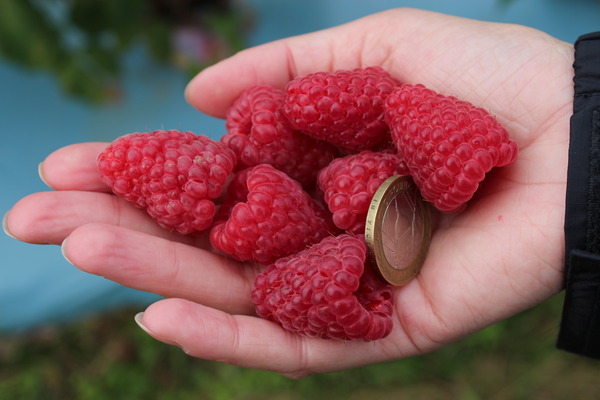
Picture: the fruits of the primocane raspberry Primeberry® Autumn Happy®, compared in size with a 1-Euro coin
Raspberry plants with yellow fruits and red fruits – which is better?
That is of course a matter of taste...But for most people raspberries have to be red; the market share of yellow-fruited varieties is about 10-15%. But especially lovers of rather sweet fruits will be well served with yellow raspberries; normally they have less acidity and are therefore somewhat milder.
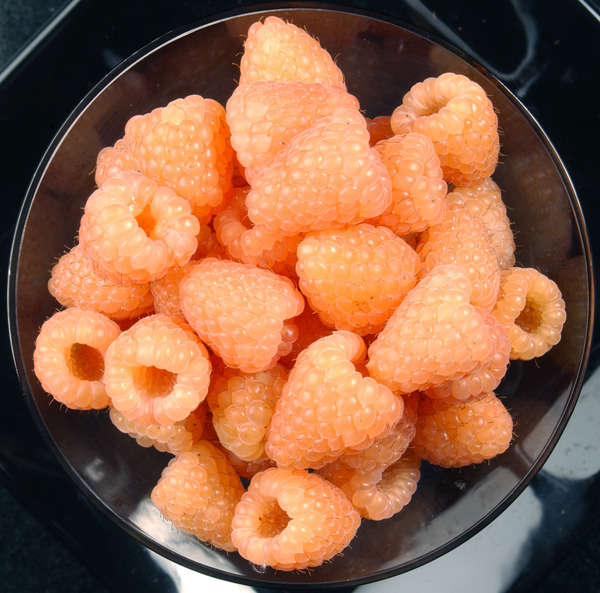
Picture: the apicot-coloured fruits of the primocane raspberry Primeberry® Autumn Amber®
Are there thornless raspberry plants?
Yes, there are, and it is also one of the breeding objectives at Lubera. Thornless raspberries are, for example, the two semi-tall Schlaraffia® raspberries 'Plentiful®' and 'Nibbleme®', as well as the extremely large-fruited variety 'Autumn Happy®' and the yellow variety 'Autumn Amber®'.
When can I harvest raspberries?
Summer raspberries ripen in June and July; autumn raspberries around mid-July until late autumn, depending on the variety. The fruits are ripe when they are well coloured. If you want to store the fruits for a while, it is best to pick them light red, sometimes almost pink, otherwise only when the colour has fully developed.
When and how should raspberry plants be fertilised?
We recommend that raspberries should always be fertilised in the spring with a layer of compost (2-3 cm) that is chopped up immediately into the soil. In addition, the availability of nutrients can be ensured with a slow-release fertiliser. Due to their large and branched root system, raspberries can also find and absorb very readily available nutrients in warm soil. If the leaves are yellow, the raspberries should be checked for mites. Here it often helps to transfer some canes from a healthy planting (where there are predatory mites). Autumn raspberries, in particular, are relatively often found to suffer from mild iron chlorosis. Here the use of iron chelate can help. This can be dissolved in water and poured on or sprayed over the leaves in smaller concentrations. As a rule, 2-3 treatments at weekly intervals are sufficient.
How can I propagate raspberry plants myself?
You should only propagate and transplant from an absolutely healthy planting area, which is also younger than five years. This is the only way to be sure that there is no virus infection. For propagation and transplanting to another location, select strong, attractive canes, cut them back to 20 cm and dig them out, then carefully plant them again at the same depth in the new location. The replanting should only be done in the dormancy period from November to early March; from experience, the March date is better because the canes will start to grow immediately.
